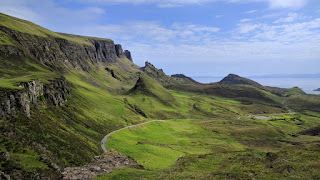 |
| Eilean Donan Castle 5x14 gouache by Michael Chesley Johnson |
Fantastic landforms--how do you paint them? The Quiraing is what’s called a “landslip,” an area where the land has literally slipped away, leaving a high ridge. Over time, the ridge has eroded into strange shapes. Grass and bracken have knitted an emerald coat over it all. As a painter, the Quiraing poses two problems: representing the convoluted, underlying geology and the incredible variety of greens so that both are believable.
The Quiraing is one of the top five tourist stops in Scotland, and by the time we got there, the wide verge was quite parked up. (There were almost as many tourists as sheep.) We had to walk a little distance to the main trail and from there dispersed to find a view that pleased us. I discovered a little nook that had a breeze--it was warm without one--and worked on resolving the problems of painting this strange land. Fleeting sun alternately turned the greens an incandescent, almost-orangey-green to a cooler, almost-blueish-green and everything in between. I’m glad I had my gouache, as it made varying the greens easier; with a small traveling kit of pastel, I would have been lost.
 |
| Quiraing North 5x7 gouache |
 |
| Quiraing South 5x7 gouache |
I had time for two sketches before we needed a break. When everyone was ready, we headed down to Staffin and the Telford House for tea and scones. Cafes and tea houses are not hard to find on Skye; every little village seems to have at least a couple.
Afterward, we headed toward a set of basaltic columns near Duntulm Castle, which is now so much a ruin that it is basically a pile of stones with a view. One of our group had requested a pastel demonstration, so I borrowed her set and demonstrated how I paint rocks. (Using a kit that is not your own is always a challenge.) Then we hiked out to the castle, where I tried to imagine what it was like oh so long ago to stand there before Instagram and Facebook and to enjoy an unpopulated view.
During the evening critique, someone asked why I paint on both sides of each sheet in my journal. “It would be hard to sell individual paintings that way,” she remarked. True, but I hadn’t been thinking of selling these sketches but using them solely as references. I did start the journal by putting one sketch per sheet, but after a day realized I could get many more sketches in this one book if I painted both front and back. So, although the sketches are in chronological order, there are a couple out of sequence since I went back and filled in those first blank pages.
The next day, we wanted to visit the famous Eilean Donan castle, which is not on Skye but just across a loch on the mainland. Although you can get to the castle via the Skye bridge, we opted to do the trip as a loop and take the Kylerhea-Glenelg ferry. We left Portree early to get a spot on the ferry, which is a tiny boat that can hold up to six small cars. The ferry is an unusual one in that it is one of the last remaining turntable ferries; the ferry’s top can be rotated to give the cars a favorable exit and entrance. When the ferry reaches land, it runs alongside the ramp, and then the captain gets out and rotates the turntable by hand so the exit of the ferry sits firmly on the ramp so the cars can leave. (I’ll try to post a video of it.) The ferry trip itself is only a ten-minute ride, and the first mate is a border collie, who provided entertainment.
Eilean Donan sits out on a little nub of rock, which you reach by a beautiful stone bridge. It’s nice having the castle separated from the coffee shop/gift shop/ticket office and car park, since that area can be quite busy with tourists who want to just take pictures and not buy a ticket to cross the bridge to the castle. After a quick lunch at the cafe, most of us walked off to find a quiet spot to paint the view. Although the morning had started with clouds, the clouds soon left and it got hot. I painted until I’d finished the one sketch, and then I returned my gear to the car (backpacks aren’t allowed in the castle) before getting a ticket and crossing the bridge.
The castle was started in the 12th century and, like many castles, over the centuries underwent a variety of additions, subtractions and renovations. In 1719, it was destroyed during a Jacobite rebellion and left in ruin until the early 20th century, when it was rebuilt by Lord Macrae-Gilstrap as a home. Today, the castle is a big tourist attraction and can be rented for weddings and other events. My favorite part of the castle was the view from the towers and ramparts of the hills edging the three lochs that meet there: Loch Duich, Loch Long and Loch Alsh.
On the way home via the Skye bridge, we stopped at the bridge to see a view of the old lighthouse--you could tell how picturesque it would have been before the building of the bridge--and then in Broadford at a silversmith’s shop. As luck would have it, the silversmith was located right next to a real estate office, where we found a lovely little croft house we liked for only 190,000. Will we end up with a summer studio on Skye? Stay tuned!
 |
| Photo by Marion Boddy-Evans |
Castle sketches by the group









